Themed collection Supramolecular chemistry: self-assembly and molecular recognition

Selectively sensing first-row transition metal ions through fluorescence enhancement
Fluorescence signaling systems that give enhancement in the presence of first-row transition metal ions are discussed.
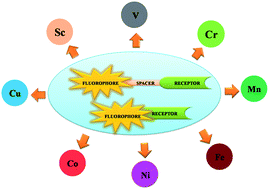
RSC Adv., 2014,4, 26585-26620
https://doi.org/10.1039/C4RA02054E
Radicals in metal–organic frameworks
We discuss early advances in the incorporation of radicals into the ever evolving class of materials known as metal–organic frameworks.
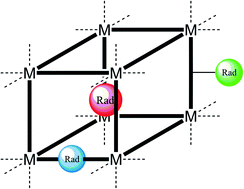
RSC Adv., 2014,4, 17498-17512
https://doi.org/10.1039/C4RA00958D
Self-assembly of supramolecular triangles with neutral trans-PdCl2 directing units
Pd(II)-directed self-assembly of homoleptic metal–polypyridyl complexes functionalized with 3-pyridyl groups gives rise to supramolecular metallo-triangles as confirmed by a combination of analytical techniques.
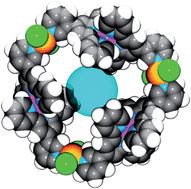
RSC Adv., 2014,4, 21262-21266
https://doi.org/10.1039/C4RA01596G
Anion-dependent spin crossover in solution for an iron(II) complex of a 1H-pyrazolyl ligand
The spin-crossover equilibrium midpoint temperature (T1/2) in [Fe(3-bpp)2]X2 (3-bpp = 2,6-di{pyrazol-3-yl}pyridine) varies from 259 K when X− = BPh4− to 277 K when X− = Br−, in a polar acetone–water solvent mixture.
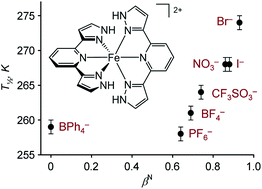
RSC Adv., 2014,4, 11240-11243
https://doi.org/10.1039/C4RA00230J
Hydrogen-bonding driven luminescent assembly and efficient Förster Resonance Energy Transfer (FRET) in a dialkoxynaphthalene-based organogel
Co-assembly of FRET donor–acceptor pair facilitates highly efficient energy transfer in gel state.
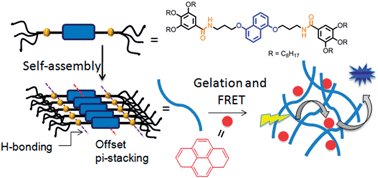
RSC Adv., 2014,4, 43564-43571
https://doi.org/10.1039/C4RA08920K
Supramolecular assemblies of semiconductor quantum dots and a bis(bipyridinium) derivative: luminescence quenching and aggregation phenomena
CdSe and CdSe–ZnS nanocrystal aggregates are formed in solution in the presence of a bis(bipyridinium) species, and disrupted upon addition of a macrocyclic host.
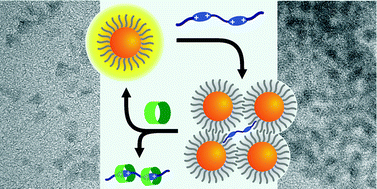
RSC Adv., 2014,4, 29847-29854
https://doi.org/10.1039/C4RA03259D
Subtle backbone modifications control the interpenetration of dibenzosuberone-based coordination cages
The self-assembly of interpenetrated double-cages was examined with respect to various synthetic modifications of the dibenzosuberone backbone.
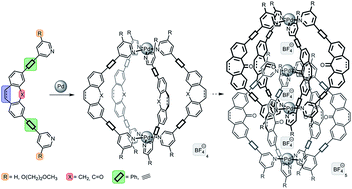
RSC Adv., 2014,4, 29724-29728
https://doi.org/10.1039/C4RA04679J
Ester-substituted cyclometallated rhodium and iridium coordination assemblies with π-bonded dioxolene ligand: synthesis, structures and luminescent properties
A series of functionalized cyclometallated rhodium and iridium coordination assemblies 2–7 displaying a π-bonded dioxolene ligand is described.
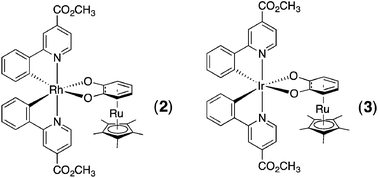
RSC Adv., 2014,4, 23740-23748
https://doi.org/10.1039/C4RA01185F
A 4-tert-butylcalix[4]arene tetrahydroxamate podand based on the 1-oxypiperidine-2-one (1,2-PIPO−) chelate. Self-assembly into a supramolecular ionophore driven by coordination of tetravalent zirconium or hafnium(IV)
K+ is encapsulated by 2 : 2 complexes of tetravalent zirconium or hafnium with the calix[4]arene podand 1H4 carrying four cyclic hydroxamate binding units.
![Graphical abstract: A 4-tert-butylcalix[4]arene tetrahydroxamate podand based on the 1-oxypiperidine-2-one (1,2-PIPO−) chelate. Self-assembly into a supramolecular ionophore driven by coordination of tetravalent zirconium or hafnium(iv)](/en/Image/Get?imageInfo.ImageType=GA&imageInfo.ImageIdentifier.ManuscriptID=C4RA00977K&imageInfo.ImageIdentifier.Year=2014)
RSC Adv., 2014,4, 22743-22754
https://doi.org/10.1039/C4RA00977K
Anion dependent silver(I) complexes of pyrazine mono-N-oxide
Pyrazine mono-N-oxide reacts with silver salts to form either discrete complexes involving monodentate N-coordination or 1D coordination polymers in which the ligand acts in a N,O-bridging bidentate coordination mode.
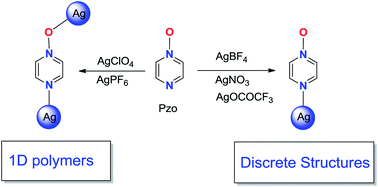
RSC Adv., 2014,4, 22449-22454
https://doi.org/10.1039/C4RA01336K
New insights into dihydrogenphosphate recognition with dirhenium(I) tricarbonyl complexes bridged by a thiourea moiety
Three thiourea ligands and their dirhenium(I) complexes are reported that show an unusual cooperative binding to two dihydrogenphosphate anions; this could explain the high selectivity for phosphate in many reported anion receptors.
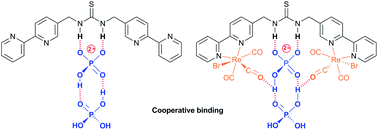
RSC Adv., 2014,4, 18442-18452
https://doi.org/10.1039/C4RA00912F
The versatility of “click” reactions: molecular recognition at interfaces
“Click” reactions allow functionalizing azide-terminated gold surfaces with host and guest molecules to examine molecular recognition at interfaces.
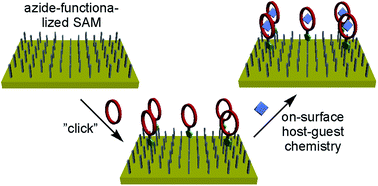
RSC Adv., 2014,4, 17694-17702
https://doi.org/10.1039/C4RA01730G
An octahedral aluminium(III) complex as a three-fold node for supramolecular heterometallic self-assemblies: solution and solid state chemistry
A ligand possessing two orthogonal metal binding sites is designed to bind three-fold and four-fold symmetric metal ions in such a way as to form a cage.
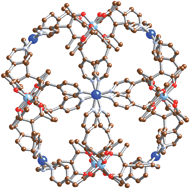
RSC Adv., 2014,4, 16686-16693
https://doi.org/10.1039/C4RA00575A
Melting temperatures deduced from molar volumes: a consequence of the combination of enthalpy/entropy compensation with linear cohesive free-energy densities
Exploiting a simple harmonic potential for modelling intermolecular interactions results in chemically intuitive correlations connecting molecular volumes with melting enthalpies and entropies.
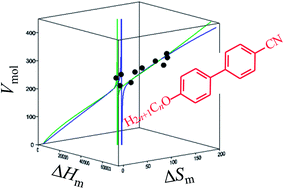
RSC Adv., 2014,4, 15740-15748
https://doi.org/10.1039/C4RA00348A
BODIPY dyes functionalized with 2-(2-dimethylaminophenyl)ethanol moieties as selective OFF–ON fluorescent chemodosimeters for the nerve agent mimics DCNP and DFP
Hand held sensing kits for detecting nerve agents simulants.

RSC Adv., 2014,4, 15975-15982
https://doi.org/10.1039/C4RA00710G
Preparation of open and closed forms of the lvt network with Cu(II) complexes of structurally related 1,2-diazole ligands
Two Cu(II) coordination polymers prepared from 1H-indazole-3-carboxylic acid and 1H-pyrazole-3-carboxylic acid form 3-D coordination polymers described by the lvt topology, and their frameworks are either of closed or open forms, respectively.
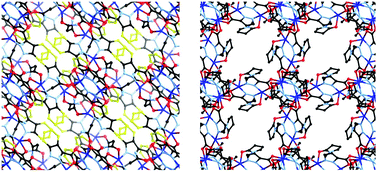
RSC Adv., 2014,4, 15770-15775
https://doi.org/10.1039/C4RA02147A
The one pot synthesis of heterobimetallic complexes from a homoditopic pyrimidine–hydrazone ligand
Three new heterobimetallic complexes have been synthesised facilely in high yield and purity from a symmetric homoditopic pyrimidine-hydrazone ligand in a one-pot, two step reaction.

RSC Adv., 2014,4, 14550-14556
https://doi.org/10.1039/C3RA47735E
Acid-induced formation of hydrogen-bonded double helix based on chiral polyphenyl-bridged bis(2,2′-bipyridine) ligands
Chiral polyphenyl-bridged bis(2,2′-bipyridine) ligands L2–4 give intense CD signals when protonated with tetrachloroferric acid or perchloric acid. X-ray crystal structure of [(L2)2H2](FeCl4)2 shows that a double-stranded helix stabilized by both interior and exterior hydrogen bonding is formed. Theoretical DFT calculations show that such stabilization exists in solution.

RSC Adv., 2014,4, 14513-14526
https://doi.org/10.1039/C4RA00849A
Bis-triazolium containing macrocycles, pseudorotaxanes and interlocked structures for anion recognition
The use of the bis-triazolium motif to prepare potent anion receptors is described. A bis-triazolium axle containing rotaxane exhibits selective halide anion recognition in competitive solvent media.
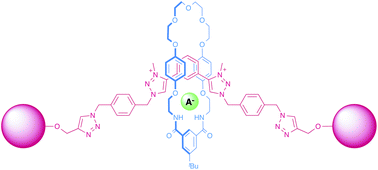
RSC Adv., 2014,4, 12133-12147
https://doi.org/10.1039/C4RA00615A
Assembling model tris(bipyridine)ruthenium(II) photosensitizers into ordered monolayers in the presence of the polyoxometallate anion [Co4(H2O)2(α-PW9O34)2]10−
Model ruthenium(II) photosensitizers with long alkyl chains are assembled into ordered monolayers on water with or without an anionic polyoxometallate. LB films on mica substrates are visualized using AFM.
![Graphical abstract: Assembling model tris(bipyridine)ruthenium(ii) photosensitizers into ordered monolayers in the presence of the polyoxometallate anion [Co4(H2O)2(α-PW9O34)2]10−](/en/Image/Get?imageInfo.ImageType=GA&imageInfo.ImageIdentifier.ManuscriptID=C4RA00085D&imageInfo.ImageIdentifier.Year=2014)
RSC Adv., 2014,4, 11766-11775
https://doi.org/10.1039/C4RA00085D
Insight into the dynamic ligand exchange process involved in bipyridyl linked arene ruthenium metalla-rectangles
Ligand exchange processes of metalla-rectangles have been explored using 1H/2D isotope labelling, showing that ligand exchange does not proceed spontaneously.

RSC Adv., 2014,4, 8597-8604
https://doi.org/10.1039/C3RA46859C
An anion-binding fluorinated alcohol isophthalamide isostere
The anion complexation properties of a fluorinated alcohol that is isosteric with a simple isophthalamide revealed that the alcohol can complex weakly basic anions with stability constants greater than those of the isophthalamide.
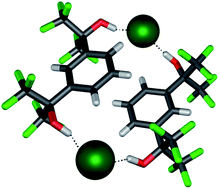
RSC Adv., 2014,4, 5389-5393
https://doi.org/10.1039/C3RA45956J
About this collection
Welcome to this themed collection ‘Supramolecular chemistry: self-assembly and molecular recognition,’ Guest Edited by Professor Mike Ward (University of Sheffield, UK). The articles presented here cover many aspects of the formation of, and molecular recognition with, non-covalent self-assembled systems. Systems studied span the range of supramolecular assemblies from MOFs to gels, and potential applications or functional behaviour that are on display here include host/guest chemistry, spin crossover, molecular sensors, and extraction/separation. This collections of articles powerfully illustrates the diversity and increasing importance of supramolecular chemistry, and we hope you enjoy reading it.